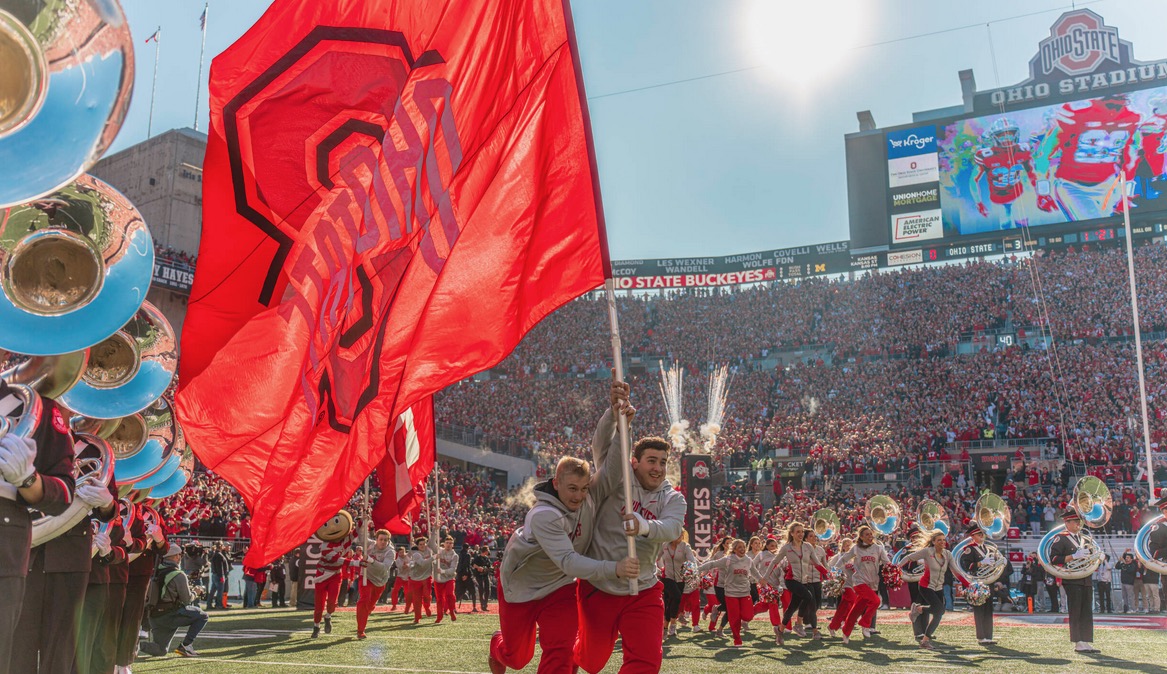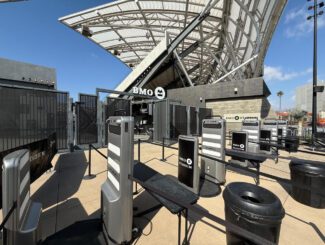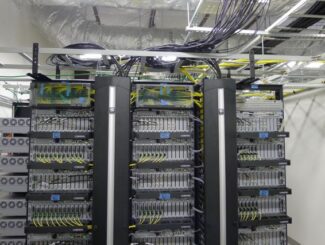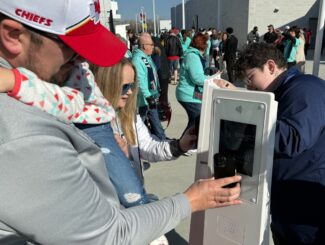
Ohio Stadium, home of the Ohio State Football team and one of the largest public venues anywhere, is now the unofficial leader in single-day Wi-Fi data used, with 34.8 terabytes used at the venue on Nov. 26, 2022, during Ohio State’s rivalry matchup with Michigan, according to statistics provided by the school.
With sellout crowds that often top 105,000 in attendance (for Michigan the attendance this season was 106,787, according to the school), Ohio Stadium quickly became one of the top spots for single-day Wi-Fi performance after installing an Aruba Wi-Fi 6 network ahead of the 2019 season. When we used to keep more exhaustive lists of the top unofficial single-day Wi-Fi events, Ohio State and “The Horseshoe” joined recent Super Bowls in the top 10 with several big days during the first season of the network’s operation.
As longtime Stadium Tech Report readers know, the NFL’s yearly “big game” has traditionally set and reset the bar for single-day Wi-Fi usage, with almost every game since Super Bowl XLIX in 2015 setting a new record. The only outlier to the trend was Super Bowl LV in 2021 in Tampa, where Covid-related security measures reduced the number of fans who could attend. Last year at Super Bowl LVI in Los Angeles at SoFi Stadium, the new “unofficial” top mark was pushed significantly forward to 31.2 TB, a jump from 26.42 TB at Super Bowl LIV in Miami in 2020. But now, the new top recorded mark belongs to the Buckeyes.
One reason we really don’t keep exhaustive list of top Wi-Fi events anymore (at one time we had the top 36 events listed, which was fun but also kind of ridiculous) is that at some point it becomes a comparison of apples to oranges, since different venues and different events have significantly different attendance totals. Over time we found the average data used per connected device a somewhat more interesting stat, since it shows whether or not fans are just connected or are really using the network. But then again, comparisons aren’t exactly equal, since the bucket-list selfie streaming at Super Bowls or BTS concerts is pretty much unmatched by other events.
Wi-Fi 6 networks are paying off
But the biggest numbers are always worthy of coverage, since they keep telling the story of how the capability of stadium Wi-Fi networks keeps expanding. One thing that seems interesting to us is that Ohio Stadium is seeing a new higher tier of Wi-Fi totals (see chart) without adding additional APs to the network installed in 2019. According to Ohio State, the network has seen significant other upgrades, including adding 60 percent more controllers, upgrading software multiple times, and “a lot of retuning” during the 2021 season.
Our seat-of-the-pants analysis seems to point to more effective and more numerous connections thanks in part to the increased number of Wi-Fi 6-capable devices, and also to the automatic offload to Wi-Fi for Verizon cellular customers.

But the network is hardly something to set and forget, according to Jim Null, senior associate athletic director and CIO / Athletics and Business Advancement at the Ohio State University.
“Wi-Fi technology and usage continues to rapidly evolve, so our teams are always working to anticipate needed changes to the network to align with industry trends,” Null said.
The Ohio Stadium network, designed and deployed by AmpThink, makes extensive use of handrail-mounted antenna enclosures to cover most of the seating bowl. Though Ohio State and other venues, like Oklahoma and the Golden State Warriors’ Chase Center, took a bit of a leap of faith in 2019 to go with the relatively new Wi-Fi 6 standard, that decision has now paid off in spades as most new devices now have support for the technology.
According to Null, more than 50 percent of the Wi-Fi traffic at Ohio Stadium is Wi-Fi 6-based from antenna to handset, which allows for all the enhancements built into the newer standard (also known as 802.11 ax). Ohio Stadium is also seeing more than 50 percent of its unique clients connected via Passpoint, a Wi-Fi technology that switches devices automatically from cellular to the Wi-Fi network once they are in range. Currently this option is only available for Verizon customers.

At the first home game of the season, versus Notre Dame, the Ohio Stadium saw 29.5 TB of Wi-Fi used, with a staggering 96,680 unique connections (a 91 percent “take rate”) and a peak concurrent connection number of 59,000 devices. For the Michigan game Null said the network stats for unique connections were unobtainable (but likely even higher than the Notre Dame game), and added that they did see 64,147 peak concurrent connections.
When you have more, you do more
In addition to allowing fans to have greater game-day connectivity, Null said the Wi-Fi 6 network has also supported an expansion of back-of-house operations, including more Wi-Fi connected concession stands, typically “portable” or moveable stands located on concourses.
“We were able to break all kinds of food and beverage records this year as well,” said Null. “But we wouldn’t have been able to do a lot of the things we did without the infrastructure.”
While some schools have balked at the large price tags that can accompany high-end Wi-Fi installations, Null sees the investment (Ohio State spent approximately $10 million on the stadium network) as table stakes for a top fan and business experience.
“It was a big number, but there’s no way to do it on the cheap in a big stadium,” Null said. “We’re very happy with what we have.”
LISTEN TO OUR PODCAST with Ohio State’s Jim Null and Oklahoma’s David Payne about big stadiums, technology and tradition.










